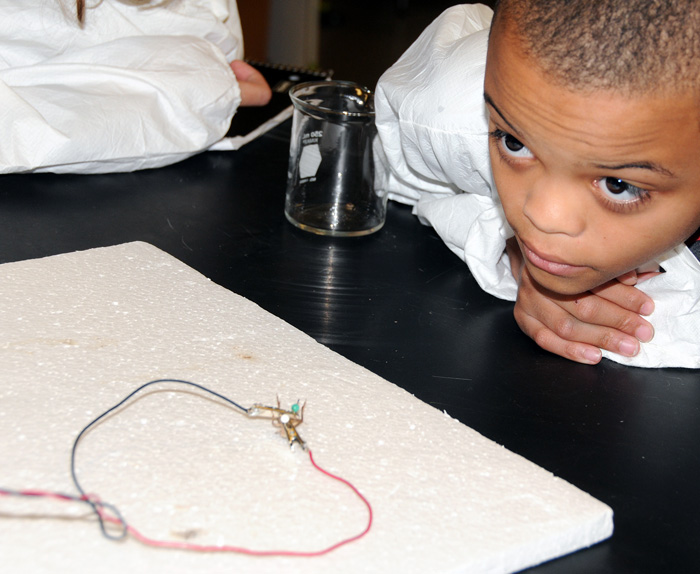Future Scientists Yearn to Learn in GEMS Program

The U.S. Army Medical Research and Materiel Command's Gains in the Education of Mathematics and Science program wrapped up a successful year, hosting 1,508 student interns, 50 near-peer mentors, 30 assistant near-peer mentors, and 13 resource teachers.
In 2013, USAMRMC and its subcommands offered GEMS participants a variety of experiences. The U.S. Army Aeromedical Research Laboratory at Fort Rucker, Ala., hosted a physical science and forensics program, as well as a robotics program. At the U.S. Army Institute of Surgical Research, Joint Base San Antonio Fort Sam Houston, Texas, students conducted experiments to learn about electricity, cardiology, blood typing, types of bacteria, DNA, dentistry, and crime scene investigation techniques. The U.S. Army Medical Research Institute of Chemical Defense's program focused on medical and chemical topics.
The Armed Forces Medical Examiner System, in collaboration with Delaware State University, created a crime-solving program where students used blood typing, fingerprinting, bone identification, and DNA to solve fictional crimes. At the U.S. Army Research Institute of Environmental Medicine, students investigated physics/forces of motion and forensics; others participated in a brain lab, microbiology tour, flame lab and robotics; a third team learned about physics, electrolysis and building a custom fuel car.
The Walter Reed Army Institute of Research offered a GEMS curriculum that involved both biomedical and engineering programs carried out in WRAIR's large teaching laboratory at the Forest Glen Annex in Silver Spring, Md., and at Wheaton High School in Wheaton, Md. The U.S. Army Medical Research Institute of Infectious Diseases hosted a "Crime Scene Investigation" program and a Battlebots program, using LEGO® remote-controlled robots in a final challenge competition where they battled each other's bots in a GEMS arena.
GEMS, a national program that runs from early June through August, gives student interns opportunities to participate in age- and grade-appropriate, hands-on activities that enable them to experience science in actual laboratory settings. During USAMRMC's program, student interns attend four- to five-day classes designed to promote development and interest in science, technology, engineering, and mathematics.
"The kids [get] to see things here that they wouldn't be able to experience anywhere else," said Capt. Carrie Quinn, a research physiologist for Thermal and Mountain Medicine at USARIEM, Natick Soldier Systems Center, Mass. "They get to truly see how science and math are everywhere—even in the Army."
The student interns are taught by college-aged students called near-peer mentors who lead the GEMS programs and serve as role models for the students. Prior to the start of the program, near-peer mentors complete extensive training in which they learn how to conduct and teach the GEMS experiments.
"This program introduces them [student interns] to totally new topics, giving them new ideas for future careers and areas of study," said Cecilia King, who is studying aerospace engineering at the University of Alabama, and served as a near-peer mentor at USAARL. "For example, I taught an interested student intern about the basic concepts of boundary layers, something that I did not even know about until college."
During the program, some of USAMRMC's labs also use assistant near-peer mentors who are high school juniors or seniors. Resource teachers oversee the near-peer mentors, providing guidance and teaching instruction.
"The mentors [were] so great, nice and encouraging to us," said Jack Gagner, 14, a student intern at USARIEM. "I would definitely like to stay involved in this program and be a mentor for others."
Learn more about USAMRMC GEMS and applications for this year's program online at stem.amedd.army.mil.














